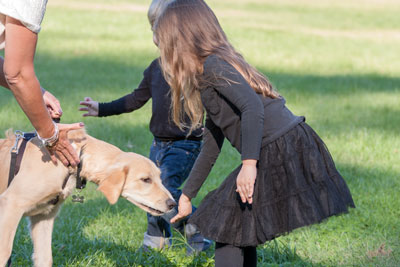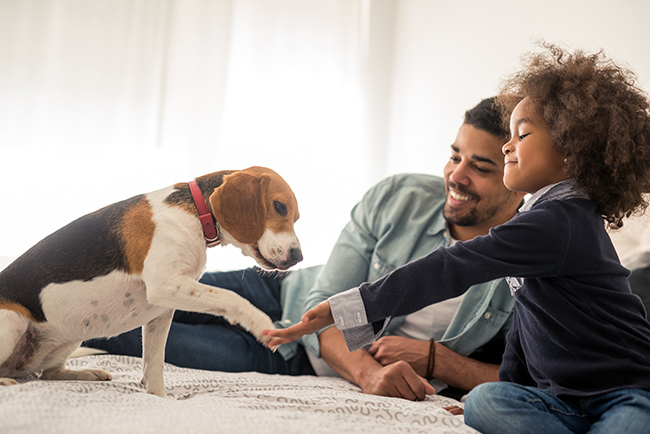How to Introduce Dogs and Children to Each Other

©kozorog/Adobe Stock
Dogs can be wonderful companions and playmates for children—and vice versa. However, the younger the child, the more cautious you should be during their first encounter.
Children are more likely to be bitten by a dog simply because they tend to move erratically, are rarely aware of the effect of their actions, and tend to be fearless. Almost half all dog bite victims are children younger than 12 years old.[1] Fortunately, by starting with a very basic protocol, you can safely begin to introduce your dog to a child.
- Keep Control: Have a ready means to safely and quickly remove your dog away should their interactions become too forced.
- Initial Positions: Have the child sit either on the floor or a chair and ask her to stay calm and still while your dog begins his initial “sniff test.”
- Never leave a child alone with a dog: Children 10 years old and younger should always be supervised when interacting with a dog
In addition to the above basic steps, there are several other things you can do to help keep children and your dog(s) safe when they’re together.
Spay or Neuter Your Dog
Unneutered dogs are three times more likely to bite, according to the Humane Society of the United States (HSUS). In fact, approximately 70 percent of reported dog bites were from intact males. If you have a dog, particularly a large breed, it’s very important to have him neutered. This is especially true if a dog is going to be living in a setting with a child.
Start Training Early

©zoeytoja/Adobe Stock
Never assume your dog is so well-behaved that he will never hurt a child. Both children and pets can have a bad day. It only takes one bad bite to endanger the life of a child and/or a dog. The best solution is to begin training and socialization (of both species) early on in life.
At the minimum, children should understand that they cannot yell, jump, scream or chase dogs. Pulling ears or tails, touching feet or other sensitive areas are also off limits. Children should understand that dogs are not toys nor are all canines the same.
Similarly, your dog should know that barking, biting, jumping, grabbing, scratching others or resource-guarding is not acceptable behavior. Your dog should also be taught that children are not toys. Dogs and children can be easily taught with positive reinforcement. First and foremost, respect for one another should be your primary training focus.
Provide a Safe Retreat
Your dog should always have a safe place to retreat to in case he becomes agitated or overly excited. If your dog is crate-trained, have it nearby during his first interactions with a child. However, just because your dog has a safe place does not mean he will use it. Children must learn that a dog’s crate is a special kid-free.
Restrain Your Dog

©Oksana Kuzmina
You should always have some form of control over your dog during his interactions with child. You should keep your dog restrained until you feel safe and comfortable with a child’s behavior, as well as your beloved pet’s. If you still think your dog does not require any restraint, keep in mind that 60 percent of all dog attacks occur at the dog’s home or in some other familiar place, according to the HSUS.
Supervised Meetings
Any meetings should be supervised by a responsible adult. You should never leave your dog, particularly a large one, alone in a room with a child. BeforeYouGetAPet.com recommends that a dog never be left alone with any child under the age of 10.
Do Not Force Interaction
You should be very familiar with your dog’s body language and cues. Being able to gauge his reaction is crucial in initial meetings. If your dog becomes too excited or displays signs of fear, lead him away and distract with treats or a favorite toy.
Children should be taught from a very young age that every dog is different and not all will respond in the same way as the family pet. They should also be taught to respect dogs, no matter the setting or situation. In addition, just because one child is well-behaved with your dog(s), does not mean other children will be.
[1] Golab, G. C., PhD, DVM. (2001, June). State Advocacy: A Community Approach to Dog Bite Prevention (abstract). In 140th Annual Convention American Veterinary Medical Association. Retrieved March 5, 2018. Doi https://www.avma.org/Advocacy/StateAndLocal/Pages/dogbite-summary.aspx#references





